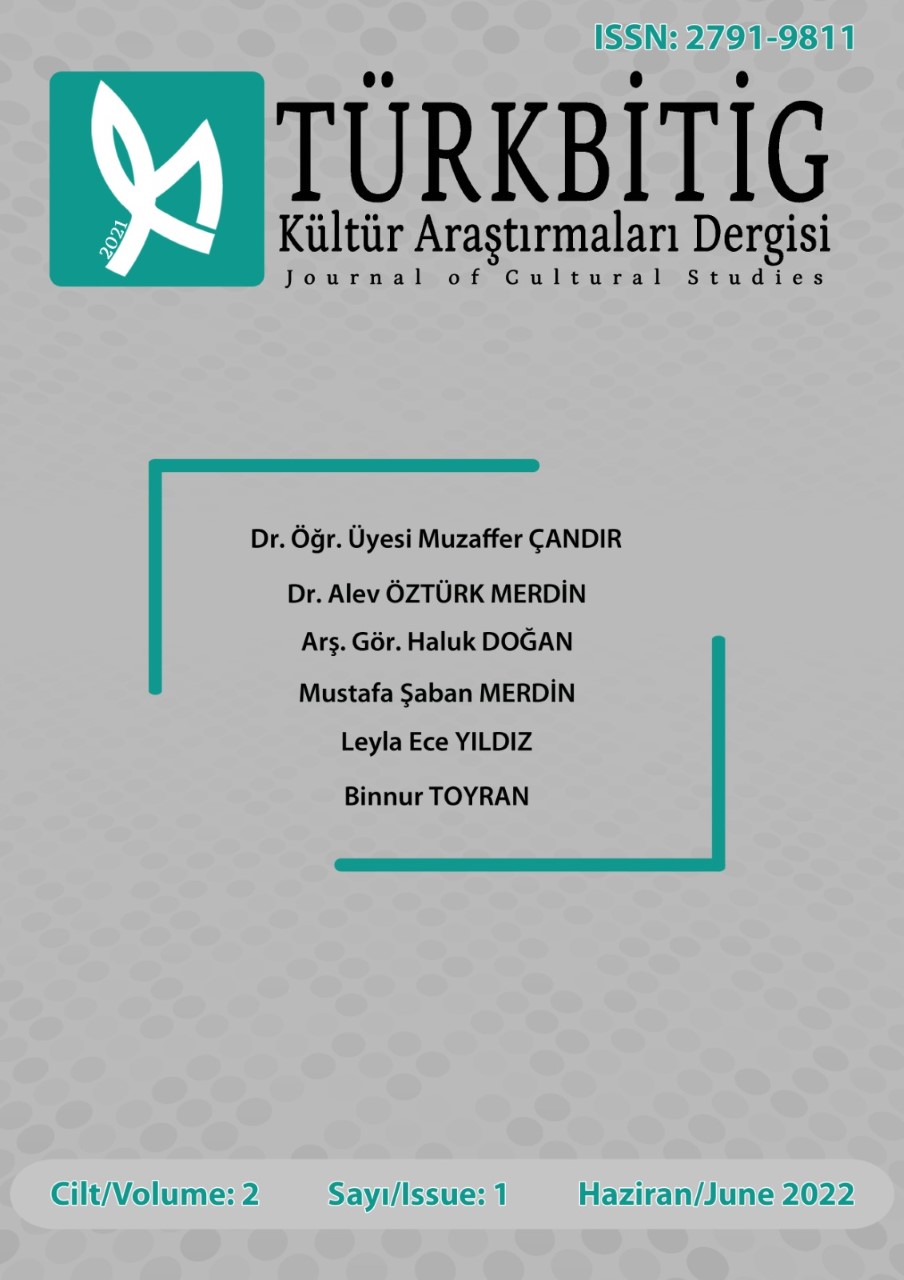Author :
Abstract
Kültürel mirasın var olmasında bağlı bulunan geleneğin özü ve etkileri ön plandadır. Geleneksel yapının özünü korumak dilin zaman içindeki gelişimiyle uyumuna bağlıdır. Özü çevreleyen en büyük unsur dil aracılığıyla aktarılan temel verilerin zamana doğrudan ayak uydurmasıdır. Halk bilimi ile ilgili çalışmaları sadece tek bir bakış açısıyla değerlendirmek belli bir sınır dâhilinde incelenmesine neden olmaktadır. Ele alınan çalışmanın hangi amaçla derleneceğini tespit etmek halk bilimi çalışmalarının da yönteminin belirlenmesi açısından önemlidir.
Çalışmanın evrenini, yapısalcılık kuramı bağlamında İskendernâme’lere bakış, örneklemini ise Ahmedî’nin İskendernâme’sinde yer alan Gülşah adlı öyküsü teşkil etmektedir. Çalışmanın amacı ise Ahmedî’nin İskendernâme’sinde yer alan ve dört öyküden biri olan Gülşah hikâyesinin yapısalcılık metodolojisinden faydalanılarak ayrıntılı bir analizinin yapılmasıdır. Konu ve üslup bakımından diğer hikâyelerden farklı yapıda olan bu hikâye sadece Ahmedî tarafından yazılmış metinde yer alması bakımından incelenmeye değer bir konudur. Çalışmamızın metodolojisinde; Dursun Ali Tökel’in Sevdâkar Şah ve Gülenaz Sultan Hikâyesi adlı makalesi de örnek metin olarak yararlanılmıştır. Barthes’in ve Propp’un, yapısalcılık kuramından hareketle; İskendernâme’de yer alan Gülşah adlı halk hikâyesi yapısal unsurlar bağlamında incelenmeye çalışılacaktır.
Keywords
Abstract
The essence and effects of the tradition attached to the existence of cultural heritage are at the forefront. Preserving the essence of the traditional structure depends on the harmony of the language with its development over time. The biggest element surrounding the essence is the direct adaptation of the basic data transmitted through the language to the time. Evaluating studies on folklore from only one point of view causes it to be examined within a certain limit. It is important to determine for what purpose the study will be compiled, in terms of determining the method of folklore studies.
The universe of the study is the view of the Iskendernames in the context of the theory of structuralism, and the sample is the story Gulsah, which is included in Ahmedî's İskendernâme. The aim of the study is to make a detailed analysis of the Gulsah story, which is one of the four stories in Ahmedî's İskendernâme, by using the methodology of structuralism. This story, which has a different structure from other stories in terms of subject and style, is a subject worth examining in terms of being included only in the text written by Ahmedi. In the methodology of our study; Dursun Ali Tokel's article named Sevdakar Shah and Gulenaz Sultan Story was also used as a sample text. Based on the structuralism theory of Barthes and Propp; The folk tale named Gulsah in Iskendernâme will be examined in the context of structural elements.
Keywords
- AKDOĞAN, Yaşar (1988), Ahmedî Divanı’ndan Seçmeler, Ankara: Kültür ve Turizm Bakanlığı
- AKDOĞAN, Yaşar (2000), İskendername’den Seçmeler, Ankara: Kültür Bakanlığı Yayınları. AKDOĞAN, Yaşar, Ahmedî İskender-nâme, http://ekitap.kulturturizm.gov.tr/dosya/ 1- 219053/h/ahmediskendernameyasarakdogan.pdf (erişim tarihi: 26.10.2022).
- ALPTEKİN, Ali Berat (1997). Halk Hikâyelerinin Motif Yapısı, Ankara: Akçağ Yayınları.
- AVCI, İsmail (2013). Türk Edebiyatında İskendernameler ve Ahmed-i Rıdvan’ın İskendernamesi, Ankara: Gece Kitaplığı.
- BARTHES, Roland (1993). Göstergebilimsel Serüven, çev: M.Rifat-S.Rifat, İstanbul: Yapı Kredi Yayınları.
- BARTHES, Roland (1998). Anlatıların Yapısal İncelemesine Giriş, çev: M.Rifat-S.Rifat, İstanbul: Gerçek Yay.
- CAFEROĞLU, Ahmet (1984). Türk Dili Tarihi, İstanbul: Enderun Kitabevi.
- CAMPBELL, Joseph (2010). Kahramanın Sonsuz Yolculuğu, çev. Sabri Gürses, İstanbul: Kabalcı Yayınevi.
- ÇOBANOĞLU, Özkul (1999). Halkbilimi Kuramları ve Araştırma Yöntemleri Tarihine Giriş, Ankara: Akçağ Yayınları.
- EKİCİ, Metin (2004). Halk Bilgisi (Folklor)-Derleme ve İnceleme Yöntemleri, Ankara: Geleneksel Yayınları.
- ERTEM, Rekim (1981). Türk Dili ve Edebiyatı Ansiklopedisi.
- MORAN, Berna (1994). Edebiyat Kuramları ve Eleştiri, İstanbul: Cem Yayınevi.
- KARTAL, Ahmet (2018). “Ahmedî’nin Mesneviciliği”, Ahmedî Sempozyumu Bildirileri Kitabı, Sivas: Sivas Cumhuriyet Üniversitesi Matbaası, ss. 19-84.
- KARTAL, Ahmet (2014). Doğu’nun Uzun Hikâyesi: Türk Edebiyatında Mesnevî, İstanbul: Doğu Kütüphanesi.
- OĞUZ, Öcal (2010). Sözlü ve Yazılı Yayılma Kuramları ve Binbir Gece Masalları, Binbir Gece’ye Bakışlar, ed. Mehmet Kalpaklı, Neslihan Demirkol Sönmez, İstanbul: Turkuaz Yayınları, ss. 39-45.
- ÖLÇER ÖZÜNEL, Evrim (2006). Masal Mekânında Kadın Olmak, Masallarda Toplumsal Cinsiyet ve Mekân İlişkisi, Ankara: Geleneksel Yayınları.
- ÖZKAN, Tuba (2006). Bey Böyrek Anlatılarının Kahramanın Yolculuğu Açısından İncelenmesi, Yayımlanmamış Yüksek Lisans Tezi, Ankara: Gazi Üniversitesi Sosyal Bilimler Enstitüsü.
- PEARSON, Carol S. (2003). İçimizdeki Kahraman, çev: Semra Ayanbaşı, İstanbul: Akaşa
- ÖZDEMİR, Nebi (2005). Cumhuriyet Dönemi Türk Eğlence Kültürü, Ankara: Akçağ Yayınları.
- SEVER, Mustafa (2003). “Edebiyatta Mitolojik ve Arketipik Yaklaşım”, Halkbiliminde Kuramlar ve Yaklaşımlar 1, Ankara: Millî Folklor Yayınları, ss. 257-266.
- TEKİN, Talat (1986). “İslam Öncesi Türk Şiiri”, Türk Dili, 409, ss. 3-42
- ÜNVER, İsmail (1975). Türk Edebiyatında Manzum İskender-nâmeler, Ankara: DTCF Yay.
- ÜNVER, İsmail (1978). "Ahmedî'nin İskender-nâmesindeki Mevlid Bölümü", TDAY Belleten 1977, ss. 355-411.
- ÜNVER, İsmail (1983). Ahmedî, İskender-nâme, İnceleme-Tıpkıbasım, Ankara: TDK Yay. Araştırmacıların Katkı Oranı Beyanı: Birinci yazar %100. Destek ve Teşekkür Beyanı: Çalışma için maddi ya da fikri olarak destek alınan herhangi bir kurum, kuruluş ya da kişi yoktur. Çıkar Çatışması Beyanı: Bu çalışmada potansiyel bir çıkar çatışması bulunmamaktadır. Etik Kurul Belgesi: Bu çalışma için Etik Kurul Belgesi gerekmemektedir.





